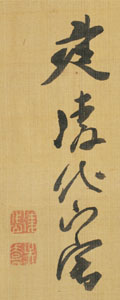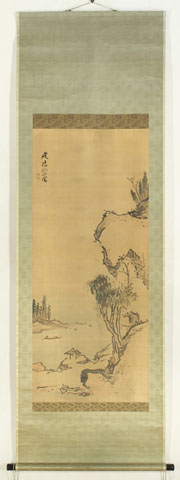Nanga
RiverscapeSigned: Ken Ryôtai sha
Seals: Ryôtai Môkyô
Technique: sumi and colours on silk 117 x 49,7
Mounting: green damask 197 x 63,8
Condition: good
Ryôtai (Kanyôsai, or Takebe Ayatari) was the second son of an important samurai family in Mutsu. He was highly educated and, in his relatively short 55 years, experienced a restless life of much variety. According to one story, at the age of 20 he eloped with his brother’s wife, but he himself wrote that he had run away from home to seek his fortune as a young child, and that a meeting he had with his mother at the age of 29 was their first encounter in over 20 years. Ryôtai became a poet and painter as well as a novelist and a native-learning philologist, excelling in all of these fields, but now perhaps most famous as the Chinese-influenced painter Kanyôsai.
He tried priesthood at the Tôfuku-ji temple in Kyôto, but after a short period in Chichibu, he moved to Edo, where he emerged as a haikai master, publishing prolifically. He returned to Kyôto, where he studied under the painter Takaki Hyakusen (1698-1753), the leading Chinese painting (Nanga) artist there. And he travelled to Nagasaki where he studied with Kumashiro Yûhi (1693-1772), the most prominent of the Shen Nan p'in pupils. He studied kokugaku (native studies) under Kamo Mabuchi from 1763, and he became an avid practitioner in this field of scholarship, publishing a number of works on ancient vocabulary, poetic phrasing and literary works, as well as novels in a literary style that summoned up antiquity. He attempted to revive the ancient katauta (half-song – which followed either a 5-7-5 or 5-7-7 syllabic structure). He also published a number of woodblock-printed albums and painting manuals, for which he became more famous as an artist than than as a haikai poet.
Reference:
Marceau 1992
Roberts p. 132
Araki p. 1636
Haiga p. 201 (# 20-21)
Price: ON REQUEST

